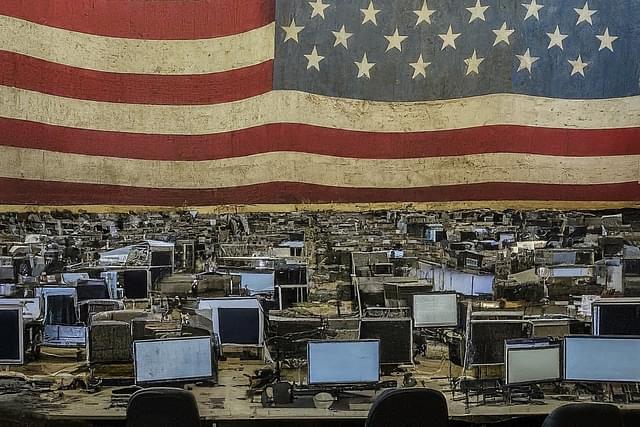Commentary
How America Exploits Big Tech For Narrative Building
Sharan Setty
Feb 29, 2024, 02:58 PM | Updated 05:37 PM IST
Save & read from anywhere!
Bookmark stories for easy access on any device or the Swarajya app.

Elon Musk recently highlighted how former officers from the US' intelligence and security agencies are strategically placed in big tech platforms like Meta and Google.
Before joining Google in 2022, Nick Rossmann spent over five years at the CIA. Now, he is handling content moderation at Google.
Whether it's Rihanna's tweets on 'farmer's protests' in India or Facebook's efforts to tamp down on Chinese 'covert influence operations', the United States has a policy to practice public diplomacy — the art of influencing public opinion in their favour.
American movies were all the rage back in the day, and the audience accepted the narrative shown in the films. This amplified the influence of what the United States could do to influence its own people and foreign audiences.
To do this, Americans began creating institutions to deal with wartime propaganda and disinformation campaigns. During WWI, the Committee on Public Information (Creel Committee) was established by President Woodrow Wilson to counter German propaganda and disseminate home-grown information to both domestic and international audiences.
After it was disbanded upon the conclusion of the war, WWII saw the establishment of the Office of War Information (OWI), approved by President Franklin Roosevelt. After the advent of the two world wars, America grew exponentially, as an economic and military hegemon. Bolstered by the Allied victory at the end of World War II, the West came to dictate terms on a global scale.
Learning from WWII, the Americans engaged in an information war with communist regimes across the world to establish a counter-revolution and spread capitalism and democracy. The United States Information Agency (USIA) was created after the end of WWII.
Before the Cold War, propaganda was disseminated not just to foreign audiences but to domestic ones too. This became a concern in countries that called themselves democracies. Attempts to make a population ‘war-mongering’ or cynical were instantly disliked.
To address this concern, academics and policy-makers coined the term 'public diplomacy', popularised by Prof. Nicholas J Cull who established its elements. Public diplomacy was supposed to achieve goodwill from audiences abroad to spread American interests democratically.
As a result, several institutions received funding, leading to a volley of scholarship programs, exchange students, and international broadcasting efforts. Most efforts focused on Central America, Eastern Europe, and Southeast Asia, where Americans faced Russian conflicts, directly or indirectly.
In the modern day, public diplomacy has evolved since the Soviet Union's disintegration. The rise of asymmetric threats, such as terrorism, changed America’s efforts in this area.
In a contemporary context, public diplomacy is understood as the government’s effort to use all available tools to influence the information environment worldwide. It also aims to facilitate dialogues to find solutions to international conflicts when needed. Initially, the lack of cultural sensibility, especially in places like West Asia, caused issues with the Muslim community in the aftermath of the 9/11 attacks.
There was a clear change in the conduct of public diplomacy after 9/11. The appointment of Charlotte Beers, former chairman of Ogilvy & Mather and J Walter Thompson, as the Under Secretary of State for Public Diplomacy and Public Affairs in October 2001, reflected this shift. An ad agency professional was tasked with 'selling' democracy to Muslim audiences in Afghanistan and other countries, with cultural sensitivities now taken into consideration.
By the end of 2002, significant progress had been made with the State Department and the BBG launching several variants of Voice of America and other radio stations across the Middle East. Broadcasting efforts to launch channels like Al-Hurra aimed to compete with “pro-terror” news media outlets like Al-Jazeera and Al-Arabiya.
All these evolutionary processes contributed to the decreasing relevance of USIA in public diplomacy efforts.
Public diplomacy aims to engage with audiences to build trust and rapport with the American establishment. This art of listening, talking, and engaging with foreign audiences using different tools became a professional statecraft of American policy circles, serving both civilian and strategic interests in places like Libya, Iraq, and Afghanistan.
The ability to manage alliances, impose sanctions, justify interventions, and pursue any policy objective is bolstered by support through public diplomacy. The US' effectiveness in maintaining its foreign policy pursuits and gathering support at international forums depends on the factor of public diplomacy.
While India has had individuals do the job (such as Narendra Modi, S Jaishankar, and Shashi Tharoor), we have failed to create institutions that can help strengthen India's image overseas.
Save & read from anywhere!
Bookmark stories for easy access on any device or the Swarajya app.
Sharan Setty (Sharan K A) is an Associate Editor at Swarajya. He tweets at @sharansetty2.
Support Swarajya's 50 Ground Reports Project & Sponsor A Story
Every general election Swarajya does a 50 ground reports project.
Aimed only at serious readers and those who appreciate the nuances of political undercurrents, the project provides a sense of India's electoral landscape. As you know, these reports are produced after considerable investment of travel, time and effort on the ground.
This time too we've kicked off the project in style and have covered over 30 constituencies already. If you're someone who appreciates such work and have enjoyed our coverage please consider sponsoring a ground report for just Rs 2999 to Rs 19,999 - it goes a long way in helping us produce more quality reportage.
You can also back this project by becoming a subscriber for as little as Rs 999 - so do click on this links and choose a plan that suits you and back us.
Click below to contribute.





